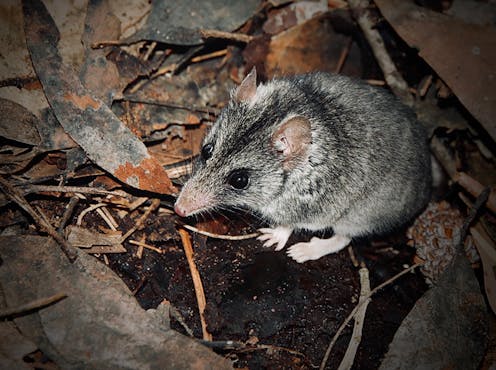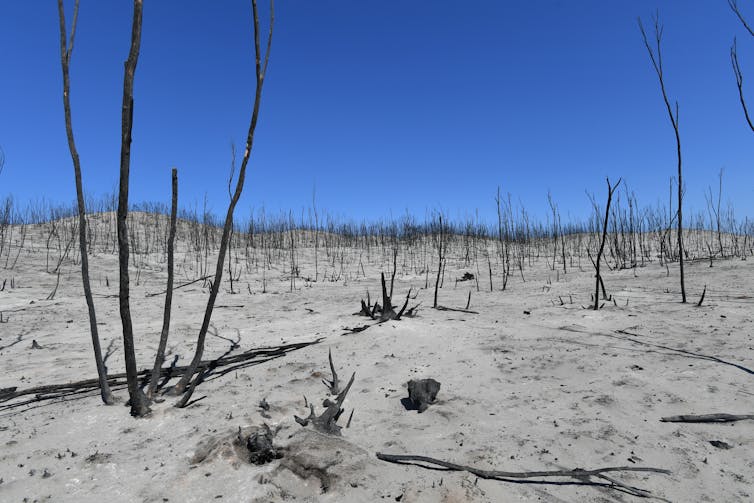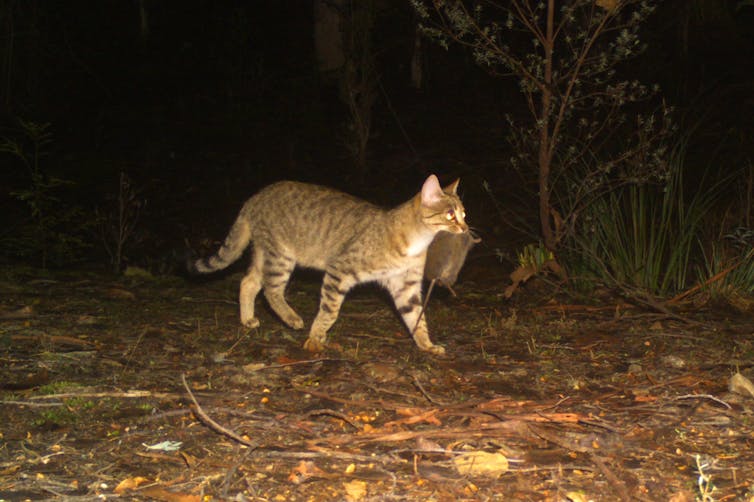Source: The Conversation (Au and NZ) – By Louis Lignereux, TBA, University of Adelaide

WWF Australia
The Black Summer bushfires of 2019-20 pushed a host of threatened species closer to extinction, including the critically endangered Kangaroo Island dunnart. And as our research released today shows, feral cats posed a second lethal threat to the species in the weeks after the disaster.
The Kangaroo Island dunnart is a mouse-sized marsupial found only on the western end of the island. Bushfires in January 2020 burnt more than 98% of its habitat. The dunnart population was thought to be about 500 before the fire; its current numbers are being surveyed but are thought to have since declined even further.
Cat predation has caused the extinction or near-extinction of several native species around the globe. Our results confirm for the first time that feral cats prey on the dunnart and did so directly after the bushfires.
The findings underscore the importance of acting immediately to protect threatened species from predators in the wake of catastrophic natural events.

David Mariuz/AAP
Analysing feral cat diets
Before the Black Summer fires, the Kangaroo Island dunnart’s habitat was fragmented due to land clearing and other pressures. Feral cats on the island were also suspected of contributing to the species decline, but this had not been proven.
A federally funded feral cat eradication program has been in place since 2015, and aims to make Kangaroo Island free of feral cats by 2030.
A 2020 study estimated there were between 1,000 and 2,300 feral cats on Kangaroo Island. We set out to determine whether cats threatened the dunnart.
We analysed the diet of feral cats humanely euthanised immediately after the 2019 bushfire. We accessed the stomach contents and digestive tracts of 86 cats captured between February and August 2020.
The cats were not killed for our study, but as part of the national feral cat control program and were euthanised in accordance with South Australia animal welfare laws. They were caught in unburnt areas where dunnarts and other species that survived the fire would likely have sought refuge.
We identified 263 distinct prey items in the cats’ stomachs and digestive tracts. They comprised:
- 195 mammals
- 46 birds
- 10 reptiles
- 12 arthropods (invertebrates such as beetles).
Among them, the introduced house mouse represented the most significant proportion, being part of the diet for 47 cats.
We found the remains of eight Kangaroo Island dunnarts in seven different cats. Three dunnarts were readily identifiable as they were nearly whole carcasses. Five more were identified based on hair features.
We observed dunnart tissue in both the stomach and large intestine of one cat, suggesting it had recently preyed on at least two individuals.
Read more:
From Kangaroo Island to Mallacoota, citizen scientists proved vital to Australia’s bushfire recovery

WWF
Our results confirm for the first time that feral cats prey on Kangaroo Island dunnarts and were efficient hunters of this species directly after the fires.
Our results provides only a small snapshot of what the feral cat had eaten. That’s because once the prey is fully digested (between 27 and 36 hours after being caught) we cannot analyse it. So the cats may well have recently consumed more prey than we could identify.
Safe to say, the cats present a substantial threat to the dunnart. We also found the remains of the endangered southern brown bandicoot in a male cat’s stomach. This endangered species is likely the last out of eight native bandicoot species still living in the wild in South Australia.
Read more:
Australian endangered species: Kangaroo Island Dunnart

University of Tasmania
Saving the most vulnerable
The Kangaroo Island dunnart is emblematic of challenges faced by threatened species across the world – especially those confined to increasingly fragmented habitats, coping with the catastrophic consequences of climate change and preyed on by introduced species.
Species already compromised can easily slide into extinction after disasters such as the Black Summer fires – the likes of which are predicted to become more frequent as the world warms and dries.
After such events, we must act immediately to protect vulnerable species from invasive predators. These measures can mean the difference between survival and extinction.
But prevention is better than cure, and we should not wait until after a catastrophic event to protect our most threatened fauna.
![]()
Louis Lignereux receives funding from Human Frontier Science Programme (Grant RGP0062/2018)
– ref. This critically endangered marsupial survived a bushfire – then along came the feral cats – https://theconversation.com/this-critically-endangered-marsupial-survived-a-bushfire-then-along-came-the-feral-cats-185133








